CONGO FEVER

3. November 2025 joerg
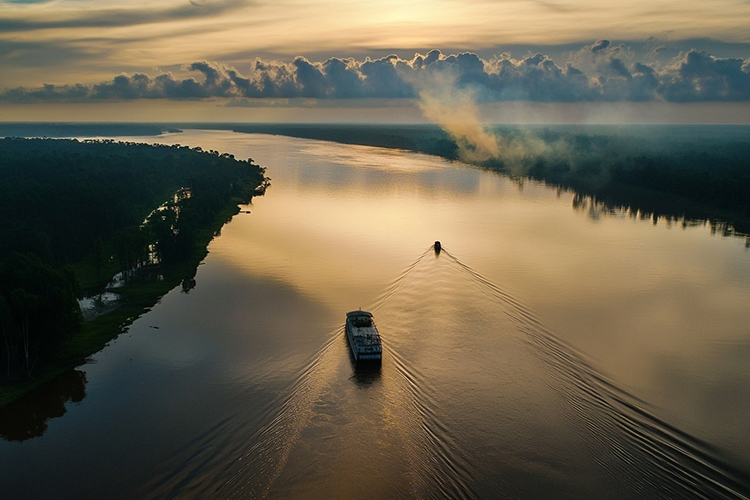 Forms
Forms
For a long time, it had been one of my dreams to travel along the Congo River through the impenetrable rainforest — to see and, above all, experience this unique nature with my own eyes, far away from noise and civilization.
Only during the preparation for the trip did we realize how complicated it actually is to enter the Congo. Backpacking in the Republic of the Congo seems to be nearly impossible. You need an official invitation just to apply for a visa, and the sheer amount of documents required is absurd.
October 12–13, 2025 – Journey to Congo
Berlin – Frankfurt – Addis Ababa – Brazzaville, Republic of the Congo.
Already at Berlin Airport, they check whether you have a valid visa. The Ethiopian Airlines staff in Frankfurt check it again, just to be sure. In Addis Ababa, we disembark and go through yet another inspection before following the path marked “International Transfers,” which, of course, leads to yet another security check. Once thoroughly screened, we are finally allowed to board the plane to Brazzaville.
Upon arrival in Brazzaville, another staff member awaits passengers as they exit the plane, checking tickets yet again — though for what reason remains a mystery. Different countries, different customs. Things get really interesting at immigration: eye scans, fingerprint scans, handing over the invitation letters, and then on to baggage claim. There, countless airport employees seem busy handling luggage. They collect baggage tags, stick them onto a sheet of paper, and record who took what and when. Apparently, luggage has been taken by the wrong people a few times too often.
After checking into our hotel, we go in search of food in the concrete desert of Brazzaville. Immediately, we are engulfed by thick blue exhaust fumes from countless cars and trucks. We balance along a narrow strip that might one day become a sidewalk. Our gaze stays mostly downward, to avoid falling into one of the deep holes that seem to lead directly into the sewers — or perhaps into the Congo itself.
Our little walk is accompanied by deafening engine noise and the constant honking of vehicles. Anyone who’s had enough of Brazzaville can escape to Paul’s — an outstanding Belgian-run bakery and restaurant, a small European oasis not far from the Congo River.
With our throats sore and our heads dizzy from the fumes, we stagger back to the hotel. From the Radisson’s infinity pool, you can look out over the Congo, where the skyline of Kinshasa emerges from the haze on the opposite bank. We hold out until dinner, and after 32 hours, we collapse into bed, utterly exhausted.
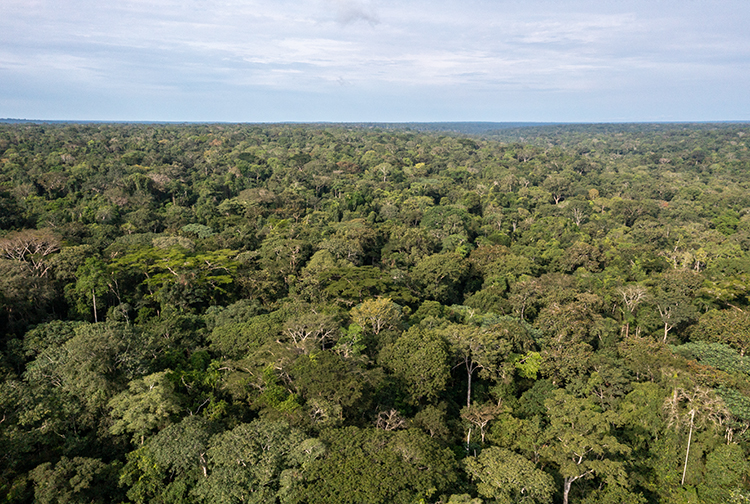
Endless rainforest in the congo area.
October 14, 2025 – Into the Jungle
With an Embraer E175 chartered exclusively for our group, we fly in the morning from Brazzaville to Ouesso in the north of the Republic of the Congo. Unfortunately, the cloud cover is so dense that hardly anything of the Congo rainforest can be seen. From Ouesso, we travel downstream in two speedboats to a bridge that the Chinese built here for the transport of tropical timber. Since then, the River Shanga has been divided, as the bridge is so low that only the locals’ dugout canoes can pass beneath it.
Beyond the bridge lies the Princesse Ngalessa. It was once the ship of the Minister of the Interior. However, since it was too large and rarely used, it was converted into a hotel ship. For the stretches we travel along the Sangha and Congo rivers, this vessel is now our home.
Only a five-minute boat ride away stands a World War I memorial, commemorating a battle where French and German soldiers faced each other in the jungle in 1914. German troops had tried to expand their territory southward from Cameroon. For a long time, the border shifted back and forth in fierce fighting. No glory, no honor—only blood and death for nothing. A stark example of the futility of any war. The Germans remained merely a footnote in Africa’s history, and only 46 years later, France granted independence to its Congo Basin territory.
A group of 25 tourists strolls through Ouesso. Aliens are in the town—and that’s exactly how I feel. We are foreign bodies here, barely able to imagine what life is like in this place. Crops, cocoa, fish, and tropical timber are the goods people trade. But Chinese low-cost products have also become increasingly present, having conquered the market in shops along the main streets. The mood at the local market turns almost hostile as the camera-armed aliens march through in single file. We make an orderly retreat, having learned very little about what life in Ouesso is truly like.
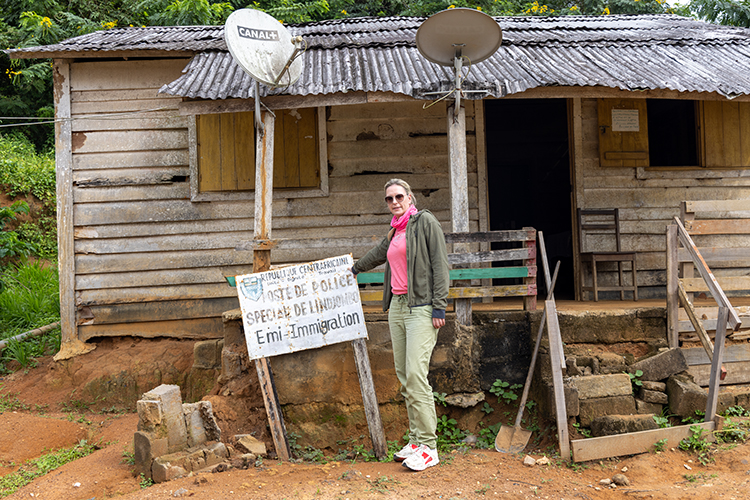
Border Station Lidjombo
October 15, 2025 – Borderlines
The early bird is a frog! Or rather, a thousand frogs that apparently don’t need sleep and have gathered in floating islands of water hyacinths to wake us with their loud croaking. The jungle slowly emerges from the morning mist along the Sangha River, which drifts lazily by as we have breakfast. Then we set out for the Dzanga-Sangha Reserve. On both sides of the river lies nothing but the vast canopy of the primary rainforest. In the enormous trees that stretch their crowns beyond the riverbanks, many birds wait patiently for their prey. In this impenetrable, eternal green, we humans from the so-called First World wouldn’t survive a week.
Because the Chinese Bridge makes it impossible for our ship to continue upstream on the Sangha River, we have to cover the 160 kilometers by motorboat. Along the way, we must stop in Oesso, at the border station to the Central African Republic, and again in Kudo to take care of formalities. For the inhabitants of the small villages along the river, borders mean almost nothing. They cross from one country to another to hunt and fish.
No rainforest without rain! We experience that firsthand when rain and thunderstorms catch us on the river. Wrapped in rubber ponchos like cocoons, we speed up the Sangha River while lightning strikes the water around us. How much protection can our aluminum boat really offer, I wonder silently? But even the worst storm eventually passes, and the sun conquers the sky once again. The soft afternoon light caresses the trees and bushes along the riverbanks, and everyone on the boat quietly soaks in the atmosphere. Around a river bend, the village of Bayanga comes into view, and we finally reach Sangha Lodge. Here, we first listen to a talk about the lodge’s behavior guidelines and then about the “Rules of the Jungle.” Unfortunately, it takes so long that I miss my planned sunset photo session.
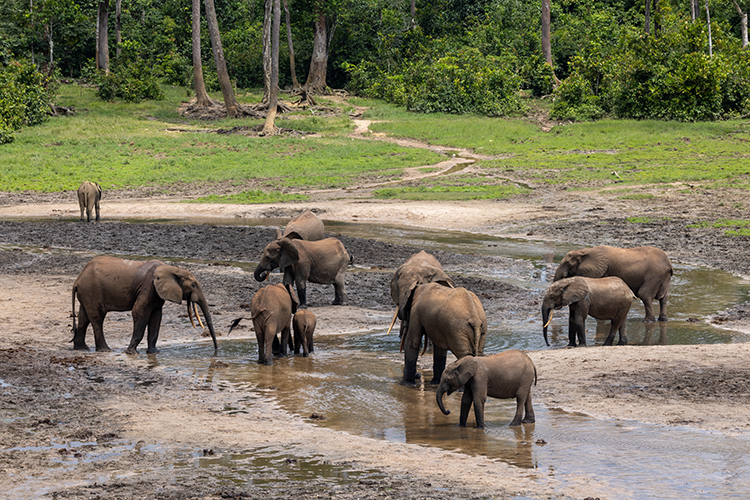
Forest elephants at forest clearing Dzanga Bai.
October 16, 2025 – Dzanga Bai
Full of anticipation, we set off on our journey. On a makeshift ferry—two canoes with a few planks laid across them—we cross the small river branch near our lodge. Then we drive in Land Cruisers to the WWF National Park headquarters. There are long discussions about who in our group is allowed to visit what, and when. Those of us staying at Sangha Lodge are not supposed to join, apparently due to some animosity between Sangha Lodge and the state-run Dodi Lodge. Then we can’t depart because trees have fallen across the road, and a little later, we hear that elephants have damaged it as well. In Congo, there are many things we simply don’t understand.
Instead of the gorilla trekking we had planned, we are reassigned to visit the Dzanga Bai, which turns out to be a stroke of luck. Bai means “clearing,” and the Dzanga Bai is considered the best place in the world to observe forest elephants. Only in 2010 did genetic tests confirm that these elephants are a distinct species, not descendants of the savanna elephants as previously believed.
We continue along a blood-red sandy track through dense jungle. After about 40 minutes, our drive ends—another tree has fallen across the road just fifteen minutes earlier. Luckily, it happens right where we were meant to start our hike anyway. After a briefing on the “jungle rules,” we begin our walk. We follow a narrow trail down through thick forest to a river, then wade barefoot along the riverbed before turning back into the jungle. We balance over roots and wooden planks until we hear the trumpeting of forest elephants in the distance. The forest opens up, and we reach the wooden observation platform that the WWF built here for research and monitoring.
We spend five hours watching the elephants as they fight, play, bathe, and suck mineral-rich water from deep holes in the ground. These minerals are the main reason why forest elephants, bongos, red buffaloes, forest hogs, and brush-eared pigs visit this treeless, muddy clearing. But eventually, everyone must leave this unique and magical place.
On the drive back, torrential rain and thunderstorms set in and last until evening. At the end of the day, the question arises: Should tourists even visit a place like this, or would it be better not to disturb the animals in their habitat?
This remote region is a paradise for poachers. The more tourists pay to experience this wonder, the more protection can be provided for the animals and the forest. That is a fact that holds true for many regions of Africa.
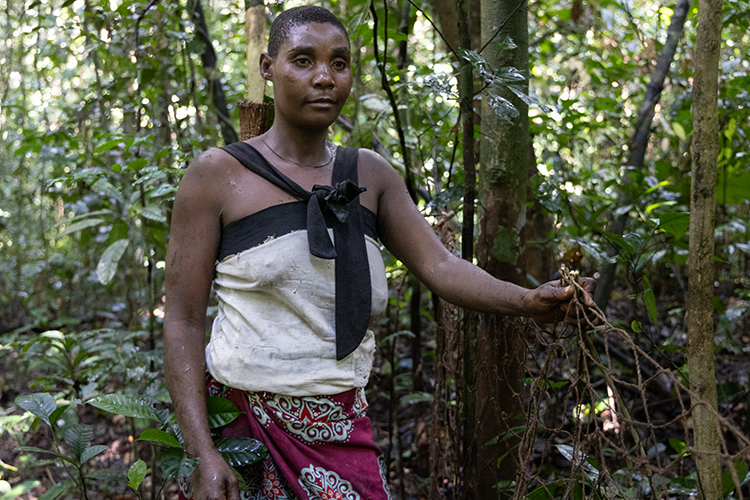
Pygmy of the BaAka tribe setting up nets for hunting.
October 17, 2025 – Jungledrum
Singing and clapping, the Pygmies stand on both sides of the dusty dirt road as our vehicles arrive in the village of Mossapoula in the morning. Everyone wants to come along on the hunt in the rainforest. They push, shout, and try to climb onto the pickup trucks. Employees of the national park administration attempt to bring order to the lively chaos. They call out, count, and wave people off — today, others are supposed to come along for once, not always the same ones.
Eventually, the pickups are full of people and hunting nets. Loudly singing and clapping, the women on the truck beds accompany us as we drive into the forest. Then the forest dims the light; the air grows even more humid, the ground soft. The crowns of the giant trees form a canopy that lets hardly a ray of sunlight through. Then we stop. The Pygmies jump off the trucks and begin unloading the nets. Everything happens with a natural ease, as if they were following an invisible choreography.
A ceremony begins. Voices rise, feet stomp, hands clap. The rhythm grows, expands, fills the forest. These are songs older than any book, prayers to the spirits who dwell here. I feel goosebumps. Maybe the forest really does listen, I think.
The BáAka read the forest like an open book. For thousands of years, they have lived in its rhythm, reading its signs as if they were a familiar script. They know which plant heals and which kills, which bark helps against headaches, which leaves ease stomach cramps, which root neutralizes snake venom — and which tree oil works as a “morning-after pill.” They take only what they need, allowing the forest to regenerate.
The hunt begins. The Pygmies move swiftly. Calls echo through the undergrowth, from here and there. I understand no words, yet the meaning is clear. The animals freeze, listen, hesitate. Then the hunters drive them together in a wide arc, a semicircular dance between humans and animals. Forest gazelles, guinea fowls, sometimes only a few small creatures are caught in the nets — but nothing is wasted. Everything is shared with the family.
These hunting expeditions can last several days or even up to two years. Then whole families roam nomadically through the forest, spending nights in makeshift huts of branches and leaves. Even in the dry season, they find water by cutting the branches of a certain tree with a machete; water then flows from the cuts almost like from a faucet.
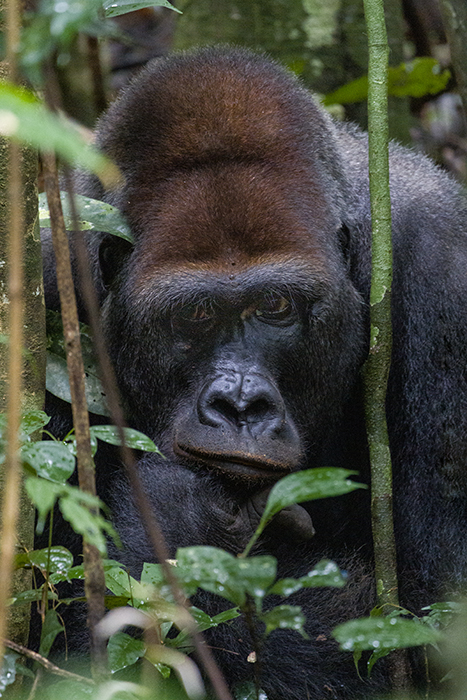 When the successful hunters return from the forest, they go to the river to cleanse themselves. Yet the Pygmies of the Congo are no dull people — even this cleansing is celebrated. They slap the water so skillfully with their hands that it produces sounds like percussion instruments. To this jungle drum, they sing loudly, and after each song, they dive into the river’s waves.
When the successful hunters return from the forest, they go to the river to cleanse themselves. Yet the Pygmies of the Congo are no dull people — even this cleansing is celebrated. They slap the water so skillfully with their hands that it produces sounds like percussion instruments. To this jungle drum, they sing loudly, and after each song, they dive into the river’s waves.
This is the world of the Pygmies of the Congo — with living traditions and rituals, without haste, without the waste of civilization, and with a vibrant faith in the spirits of the forest.
October 18, 2025 – Gorilla Trekking
After two male gorillas died within just a few months in 2024 and the groups scattered throughout the jungle, gorilla trekking was no longer possible. For the national park and the two lodges, it felt like a second COVID epidemic. Fortunately, after an unusually short time, in early 2025, the females found two young males who took over leadership of the groups. These new leaders were gradually habituated to humans, so that today, visitors can once again see a group with eleven members.
From the WWF station, where visitors undergo COVID tests, we drive along a red, rutted dirt track through the dense jungle. At the ranger station of Hokou Bai, every visitor is required to attend a briefing on proper behavior when encountering gorillas. Before entering the forest, shoes must be disinfected and hands washed once more. Then the rainforest swallows us whole. We cross streams and push through thick undergrowth, venturing deeper and deeper into the green hell. We stoop under low-hanging branches and climb over fallen trees.
When we finally reach the gorillas, we crawl through the underbrush to find a good position for photos. Of the eleven-member group, we only get to see the silverback — and not even very well. That’s nature! It decides whether we’re the lucky ones or the losers. After three hours, we emerge from the jungle completely filthy and drenched in sweat, and it’s clear: today, we were the losers!
October 19, 2025 – Olive Colobus Trekking
Already in the evening, lightning flashed across the sky, followed by rolling thunder. A storm over the Sangha River put on a spectacular light show. During the night, the drumming of raindrops on the thatched roof accompanied the song of the insects. Unfortunately, it was still raining in the morning. Nevertheless, we set out toward the Hokou Bai station, 30 kilometers away, from where we had started yesterday’s gorilla trek.
The rain continued relentlessly. An hour through mud, streams, and dripping wet rainforest would have been necessary to see olive colobus monkeys. So we decided to skip this excursion, while the tireless ones tried their luck.
On the way back, we spotted two forest elephants in the thicket beside the road. The residents of a few small huts watched the animals from a respectful distance. When one of the elephants moved a bit closer to the road, a father of two picked up his children and ran away. The fear of these animals seems deeply rooted — when elephants or leopards come too close to the villages, they are often shot.

Our vessel „Princess-Naglessa“ floating down the river Congo.
October 20, 2025 – Sangha River Cruise
After breakfast, we speed downstream from Bayanga back into the Republic of Congo. The outboard motor roars, and the cold morning air cuts into my face. Around a river bend, an unusually large silhouette appears on the water. I stare stupidly, trying to figure out what it is. I could have just pulled out my telephoto lens. Two hippos! Startled by the three motorboats, they dive underwater, of course. Three boats, three engines, a handful of people — and somewhere down below, two massive giants. They surface briefly to check if the coast is clear.
We glide further along the Sangha River, stopping at border posts to take care of formalities in shabby wooden shacks. The current pulls us downstream, and the ride takes over an hour less than our upstream journey. Small fishing camps drift by — men paddling narrow dugout canoes from bank to bank. Smoke rises from campfires, children wave, and somewhere, the clatter of a cooking pot echoes through the jungle.
In the afternoon, we reach the Princesse Ngalessa, complete with air conditioning and an open bar. As evening falls, a golden veil settles over the Sangha River. The water glows like molten copper. The trees along the banks turn into dark silhouettes, their reflections merging with the flowing current until they dissolve into deep black. The Sangha carries the light away — quietly, majestically — until morning.
October 21, 2025 – The Jungle Ghost
Late last night, a spaceship landed on the riverbank near the small village of Ikélemba. The fishermen, who in the morning had to paddle a wide arc around the steel monster, carried the news back to the village.
Immediately, the children ran down to the banks of the Sangha River. There it was! Three stories high and as long as a rainforest tree is tall. To get a better view, they climbed onto a bush at the water’s edge, its branches bending low under the weight of so many children.
When they caught sight of the pale-skinned people, they began to sing. The pale ones waved back and lifted their cameras. For a while, it went on like this — the children singing, the pale ones taking pictures. Between them, the trench of worlds.
Then the monotone hum of the machines rose, and the steel beast exhaled black smoke into the clear air. Slowly the spaceship moved away from the shore, turned, avoided the shallows, and continued downstream.
When the ship reached the small bay of Tokou, half the village was already standing at the riverbank. The people of the village sang, their voices full of joy and expectation echoing far across the water.
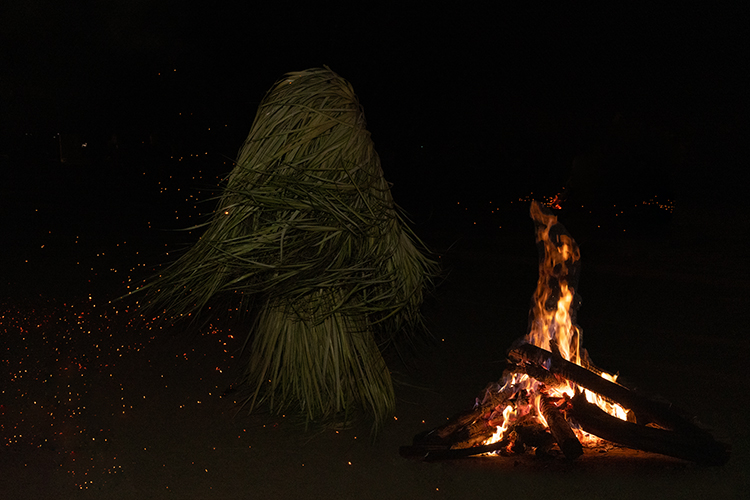
The mystic jungle ghost Ejengi has many names.
The sun broke through the clouds as if it, too, wanted to watch. The strange beings from another world stepped cautiously ashore.
But hardly had they set foot on the ground when the crowd swallowed them up — a current of loud voices, hands, laughter, and song, led by ecstatic drummers. Dust rose, feet stamped, bodies spun in circles. Some were already dancing in trance, intoxicated by movement, music, and a little by the liquor.
On the sandy clearing beneath the tall palms, everyone gathered for the encounter of peoples — peoples who could hardly be more different.
Eyes met: cautious, curious, shy, and yet full of longing.
Two worlds stood facing each other, and for a moment, there was a sense of familiarity.
Curiosity found its way — softly at first, then bolder:
How do you find work where you come from? What do you do? How do you find a partner, a home, a future?
The most intriguing question: would we accept a white person marrying a black person?
The answer was a hesitant yes.
And yet, standing among these people, I thought: We are all human, and everyone should have the same rights and chances.
Then, for a short while, we were allowed to be part of their daily life.
A woman showed how to brew medicine from healing plants; we built a hut from branches and leaves and tried our hand at weaving a reed basket.
For the Ndzengi ceremony in the evening, a fire was lit. Again, the drums began to beat, and songs rose above the treetops.
No one has ever seen his body; his hair of leaves must never be touched. With every step, the fire flared higher, sparks flying into the pitch-black sky. The people sang and danced, the shadows danced with them.
Then, from the dark of night, he appeared — the forest spirit. He floated toward the people, slowly at first, then faster. He was huge, then small again, his movements wild.
They sang, they shouted, they clapped to the rhythm of the blazing flames — and for one moment, everything was one: human, earth, spirit, ecstasy.
Then — a blinding shower of sparks — and the Ndzengi vanished as suddenly as he had come.
Only the crackle of the fire remained, while far away, mystical lightning lit up the sky, and one could almost hear the whisper of the Ndzengi from the forest:
„Dance, sing, and live — I will give you what you need, if you do not abuse me.“
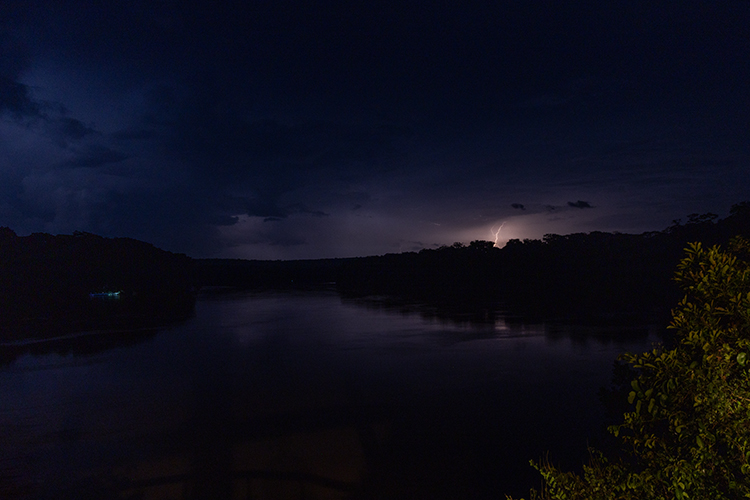
A thunderstorm illuminated the night sky over Sangha river.
October 22, 2025 – Green Hell or Wonderworld of Life?
The sky is gray and heavy with thick clouds. A veil of mist lies over the forest and river. The insects and birds still seem to be asleep. Only a few locals paddle their dugout canoes through the canal in Tokou-Pikunda National Park.
After breakfast, we glide by boat through channels almost completely covered with water hyacinths. The sun has now dissolved the clouds, and the air is hot and humid. The branches of giant mahogany and kapok trees stretch from bank to bank, forming a green canopy. At a shallow riverbank, we land and set out into the forest with local guides. The men clear a path with machetes. Orchids bloom high in the treetops, mushrooms glow on the forest floor, and ants build their roads. Lizards hide beneath leaves, a blue butterfly hovers above the group. Elephant tracks here, bongo antelope tracks there—everything is connected.
As we return by boat, we pass a fish trap. A python has become caught in it. The fisherman has knocked out its teeth with a machete—its death sentence. The animal, over two meters long, is taken to the village and divided up. An important source of protein for the people living along the river.
When the Princesse Ngalessa reaches the village of Pikounda in the afternoon, dark blue clouds gather. Lightning flashes, thunder rumbles, and the rain begins. A tropical downpour forces the visitors to remain on board for the rest of the day.
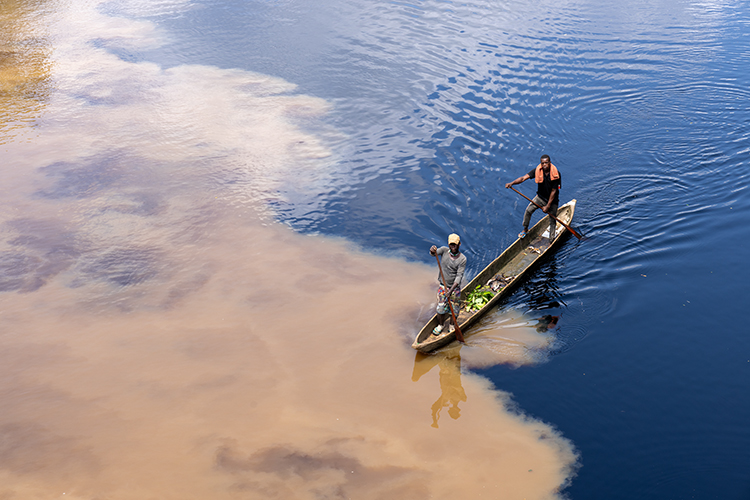
Fishermen pass the confluence of the brown water of Sangha River and the clear water of Ndoki River.
October 23, 2025 – Crossing the Equator
The thunderstorm has passed, and the rear guard of the clouds stands no chance against the morning sun. In no time, the sky turns blue, and we can now visit the village of Pikounda.
Once, Pikounda was a trading post that thrived on the activities of a certain Mr. Truchot. Nothing remains of its colonial splendor. Today, it is dominated by the Bongili people. We visit a woman who runs an improvised distillery, where she produces liquor from corn and starch.
But even the strongest spirit cannot ward off the insidious surprises the jungle holds for the unsuspecting. Among them, stomach and intestinal infections with severe diarrhea and bites from oversized insects are the more harmless ailments. Some travelers came into contact with flies whose larvae burrow under the skin and grow into worms there. Thus, this afternoon, several of us must undergo minor operations to remove the larvae and worms.
Meanwhile, our ship glides quietly downstream, the water shimmering silver in the afternoon sunlight. A gentle breeze sweeps across the deck.
After a while, a small fishing camp appears on the riverbank—two simple huts made of wood and reeds, with a few boats floating nearby. We dock and go ashore. Inside one hut stands a smoking rack, laden with fish and part of a goat. The fire glows hot beneath it, fed by wood that gives the meat its distinctive flavor.
The men of the camp show us their fishing techniques, laying traps in the river and patiently waiting for fish to swim in—a craft they have mastered over generations.
The sun sinks behind the ship and the rainforest, and the clouds turn orange. The play of colors shifts from one side of the vessel to the other. The Sangha River now winds through the rainforest in tight curves like a snake. The crescent moon peeks over the treetops, and soon we are enveloped in the darkness of night.
Then we cross the equator and celebrate this event—a milestone every traveler should experience at least once.
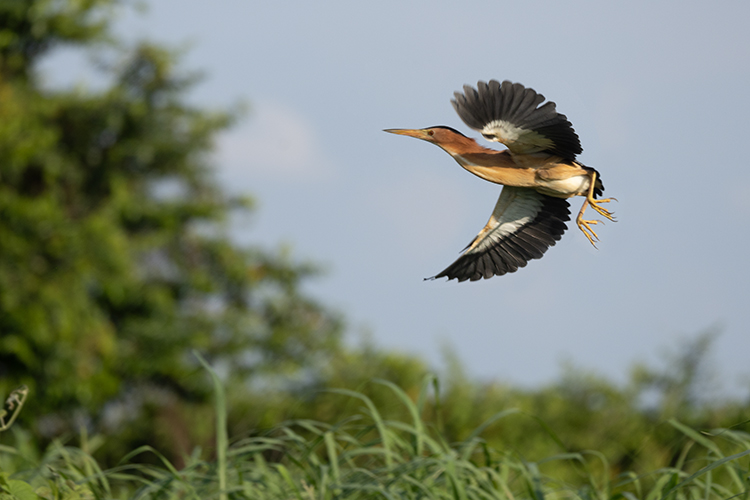
Little Bittern is escaping of photographer.
October 24, 2025 – Turboking
Morning workout on deck, right next to the whirlpool — sounds like paradise at first, but feels more like bootcamp with a view. There are only four of us, and the drill instructor is a crew member made entirely of muscle. He’s training muscles in me I didn’t even know existed. After twenty minutes he shouts, “Last exercise!” — twelve times. The pain is slowly becoming unbearable.
At breakfast, I try to shovel back in all the calories I lost — mainly so my pants don’t fall off later on the promenade deck. One scrambled egg, a kilo of pineapple, and ten pancakes with chocolate spread.
While the fitness enthusiasts of the group head out for a paddleboat excursion, we declare the sundeck our private beach. Just us, the bar — and the deceptive calm before the tropical storm. Dark clouds tower up, the wind picks up, the river foams. Lightning flashes, rain pours down, and the paddle team returns much faster than expected.
We continue our journey downstream as the landscape begins to change. The dense jungle recedes, replaced by open plains, some of which are used for agriculture.
At sunset, we take speedboats into a side arm of the Sangha River. The water glimmers in the last light of day, while kingfishers perch on branches along the shore, their bright blue feathers flashing in the sun. Between the reeds, weaverbirds are busy repairing their intricate nests, and high above us, kites circle — calm, almost majestic.
Our “spaceship” finally docks at a large tree in Likendze. Evening falls, and we set off toward the “village pub.” It’s made of round wooden logs with the gaps filled in with clay — like most huts here. Only the glaring LED lights and the pounding music reveal that this is the village’s social hub.
We have a few Turboking beers (yes, that’s really the name) and dance as best we can to the music. But the speaker relentlessly plays the same song on an endless loop. Six pale faces in a local bar — apparently a sight that draws attention. One by one, villagers from the area start showing up to watch the unusual spectacle.
Outside, the chorus of the night grows louder: cicadas and frogs almost drown out the music. The day ends just as it began — with the sound and rhythm of the jungle.
October 25, 2025 – The Congo Myth
In the early morning, gray clouds drift over Likendze. The river lies still, only occasionally rippled by a gust of wind. After breakfast, we set off to visit the fishermen. With calm, practiced movements, they show us how they cast their nets—a dance of strength and precision. The rope whistles through the air, the net opens like a bell, falls into the water, and disappears. We are also shown how palm oil is made—palm fruits, steaming vats, and the intense smell of oil and smoke.
By midday, the sun blazes mercilessly over the village. On a dusty clearing, our sailors face off against the “Likendze Eleven.” For the first time, they manage a 1:1 draw—a small triumph, even if the game feels a bit like a filler. Yet moments like these matter, for the relationships with the villages along our route must be nurtured—and sometimes, that happens best with a ball.
Then we set sail again. The ship glides slowly between dangerous sandbanks. The river widens, the banks grow barren. The rainforest has vanished from sight. In the distance, great columns of smoke rise—a sign of slash-and-burn clearing.
We pass Mossaka, where the Sangha and Congo rivers meet. On the foredeck, we savor the moment. Here, the Congo stretches up to ten kilometers wide. In its center lies a maze of islands—swampy, green, and impenetrable. During the dry season, fishermen settle on the few patches of solid ground.
Once more, we board the speedboats and try to spot birds in the side channels. But the day’s true spectacle is not a bird—it is the sighting of one of the traditional passenger ships. Deafeningly loud, trailing a plume of black exhaust, it makes its slow way down the Congo. People stand on the roof, waving to us. On deck, makeshift cabins crowd together; on the bow, passengers camp among the cargo. Behind the engines, two latrines made of corrugated metal have been added, their waste going straight into the river. It’s a sight so surreal and yet so real that no post-apocalyptic film could stage it better.
As the sun finally sinks below the horizon, the sky is ablaze. The water reflects red and gold, and for a moment, everything seems to stand still. The myth of the Congo—wild, contradictory, overwhelming—has come alive for us today.

Logs from the rainforest, goods, people—ships on the Congo river are like floating cities.
October 26, 2025 – Waiting
The vast waters of the Congo River and the frequent rain create high humidity, which condenses into thick clouds at night. So, on this morning, there is no sunrise to be seen either. A pale light bathes the landscape in a dull bluish gray; the water appears heavy and impenetrable. The river is wide, almost like a lake. Mist lies over its surface, slowly dissolving as the first fishermen glide out silently in their narrow dugouts. The wood of their boats is darkened by the water, their movements calm and assured, as if they themselves were part of the river.
As the morning progresses, the sky brightens slightly, but the sun remains hidden. Instead, a heavy, almost tangible warmth settles over everything. We wait! We wait until the afternoon before crossing to the eastern bank of the Congo River by speedboat — into the Democratic Republic. A littered stretch of shore. One of the wooden passenger boats lies in the bay, its hull coated with tar, the superstructure blackened with soot. Women wash clothes in the murky water, naked children bathe. We jump from the boat into the germ-laden mud and climb the steep riverbank. For over a kilometer we walk, carrying all our gear, from the landing site through the village until we reach the Land Cruisers. Cars are something special here. About a hundred children have gathered, shouting and screaming. It feels as if people here are less reserved than in the Central African Republic. The children drum with all their might on the car doors, and we’re relieved when we finally drive off.
The Land Cruisers race along a narrow sandy track through the bush, at times reaching 80 kilometers per hour. For long stretches, the road can best be described as a footpath. Occasionally we drive through grass as tall as a man. We pass small settlements of the Teke people, who are native to this region and still have their own queen today. Queen Ngalifourou is the guardian of “Nkwembali,” the spiritual god of the Bateke, and she is one of the most powerful traditional authorities in the country.
The houses in the villages are mostly built of sun-dried bricks and roofed with corrugated metal. Here and there are small fields, banana plants, goats, and cattle — the basis of the inhabitants’ livelihood. After 35 kilometers we reach the camp near Tshumbiri, from which the Mbou-Mon-Tour project operates. This project is dedicated to the protection of bonobos, which live only in the tropical forests of the Democratic Republic of the Congo. Bonobos and chimpanzees are considered humanity’s closest genetic relatives. The protection of these animals is part of the Mbou-Mon-Tour project, which focuses on conserving biodiversity and promoting the socioeconomic development of the surrounding communities.
Funds from the WWF and tourism are invested here in a school, a health station, and park rangers. In return, the forest and the bonobos are protected. In essence, it’s a mild form of blackmail, and one has to wonder why people wouldn’t want to protect their home and livelihood of their own accord.
Men, women, and children from nearby Tshumbiri gather around the campfire. Drums are brought and laid close to the fire so that the animal hides stretched over them become supple and produce a good sound. Then the first voices rise above the bush into the pitch-black night sky. The drums set in, and a rhythmic dance with almost animalistic elements begins in the glow of the fire. The mystical flicker of distant lightning forms the perfect backdrop — and for a moment, it seems as if even the stars pulse in rhythm with the drums.
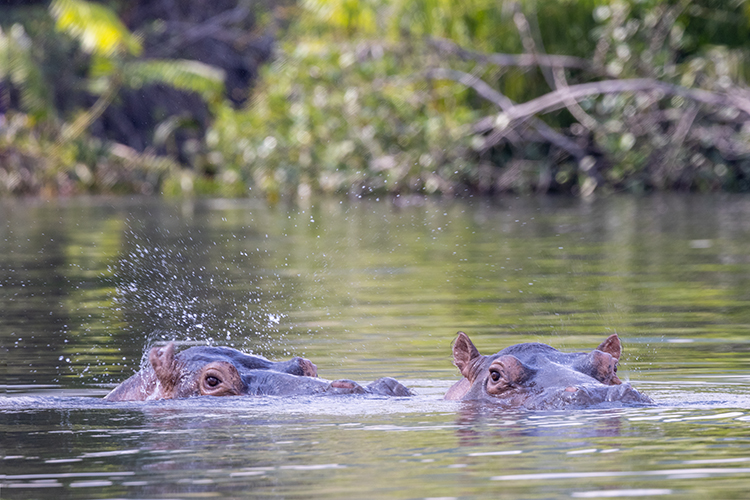
Not far from where the Lefini River flows into the Congo River, a family of hippos has settled.
October 27, 2025 – Rainforest Trekking in the D.R. Congo
The night was short, the camp beds narrow. At three in the morning, the alarm tears us from sleep — or from a half-sleep, since hardly anyone slept well. We have to flee our tent in a hurry: millions of ants have discovered the campsite and are swarming over us. We take refuge in the Land Cruisers.
Eight people and their backpacks squeeze into the interior, while three guides cling to the bumper outside. The engine roars, and we rumble off — into the dawn.
An hour and a half later, we stop in the middle of the jungle. The air is thick with the smell of damp earth and decaying leaves. A narrow path leads into the forest, and our group sets off. Sixteen people stumble through the undergrowth, climb over fallen logs, duck beneath vines and branches.
Slowly the sky turns gray, light filters through the dense canopy. Then suddenly, there’s movement high in the trees. Bonobos! Graceful and almost silent, they swing through the treetops — searching for the best spots at the forest’s breakfast buffet. For us below, they’re mostly just shadows, dark silhouettes against the dim light.
Again and again, we hear their calls — the shrill cries as they quarrel or chase each other playfully. We follow them for over an hour and a half until, quite suddenly, we find ourselves back on the track. And then, unexpectedly, not 15 meters from the path — for the first time, we can see their faces clearly. They look curious, intelligent, almost human. Just a brief moment — but one none of us will soon forget.
Afterward, we drive back to the “harbor” and cross from the D.R. Congo back into the Republic of the Congo. (I keep getting confused with all these Congos.)
Our last excursion on the Congo River is a boat trip on the Likense River, which flows into the Congo. Here, a family of hippos appears in the afternoon sun. Then we return to the ship. The deck of our vessel becomes the stage from which we watch the life of the people along and on the Congo River.
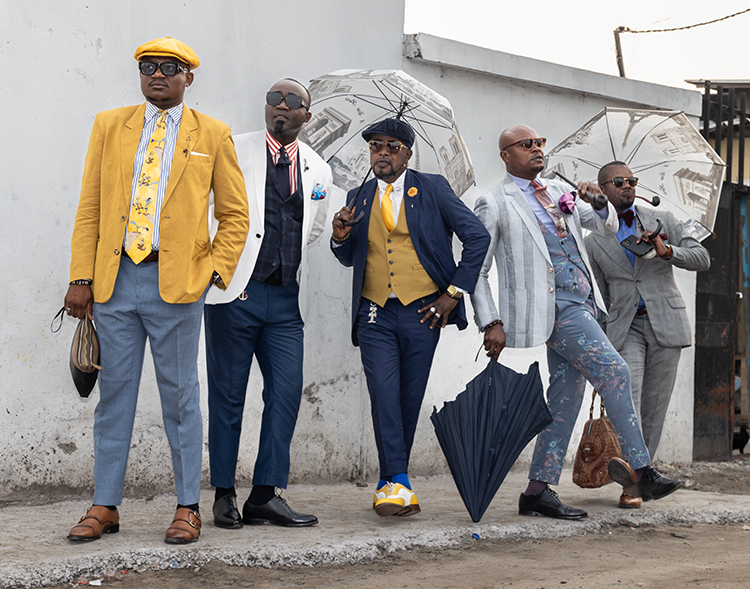
The most beautiful sight in Brazzaville—the Sapeurs
October 28, 2025 – Brazzaville
Wide and sluggish, the Congo drifts along. Hills rise on one side, while the opposite bank lies flat and deforested. The leaden, cloud-laden sky hangs heavily over everything. The ship’s engines thrum deeply as it moves with the current toward Brazzaville. Everything seems to linger in anticipation – not of an event, but of the slow passing of time itself.
Sapeur and Sapeuse
During and after colonial rule, it was relatively easy for Congolese people to travel to France to work. Some returned wearing the latest haute couture suits, using fashion to express their financial success. Over the decades, this evolved into a unique cultural movement. The name of these Congolese dandies comes from the district La Sape. Today, there are even women who dress as Sapeurs, and they are hardly distinguishable from the men — a dilemma for the gender police! Should one “gender” here or not?
Most Sapeurs have regular jobs — and they must, because their evening hobby of dressing extravagantly does not come cheap. What began as a fashion statement has grown into something much more. They are now an integral part of Brazzaville’s cultural scene — and, in my view, the city’s only real attraction. Even companies have discovered Sapeurs as models. Local beer brands and international corporations alike have already booked them for campaigns.
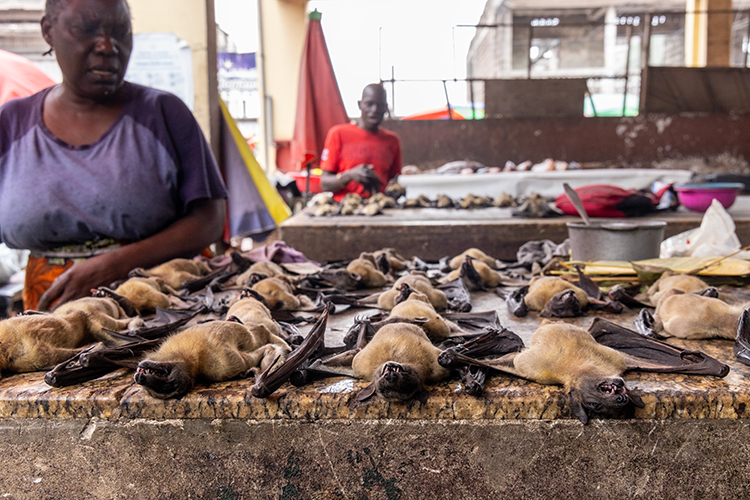
Bushmeat everywhere in Brazzaville.
Bushmeat
Bushmeat belongs to the Congo region just as Coca Cola belongs to the United States. So we two oddballs (Norbert Eisele-Hein and I) head to the Total Market. The name says it all! Here you can find everything that agriculture, livestock, and fishing in the Congo have to offer. But it doesn’t take long to find the first wild animals: monkeys, forest antelopes, rodents, and bats — the latter in great quantities.
One of the traders shows us how he tears the wings off a bat and then ties the animal into a neat little bundle — using his teeth in the process. It hardly needs to be said how dangerous bats are as carriers of disease.
Another bushmeat market is officially closed, but in front of a doorway, two crocodiles lie on the dusty pavement. We stop and ask if we may take photos. For a small fee, we get permission. The traders are thrilled and begin posing with the live animals. Gradually, more and more creatures are laid out in front of the shop: four crocodiles, a monitor lizard, and turtles. A whole tub of turtles is dumped onto the ground. Hundreds of flies circle another tub containing a dead monkey, a rodent, and the middle section of a huge python that must once have been seven meters long.
Then Lady Rosalie, the shop owner, appears. She regards our activities calmly and even takes selfies with us. It turns out this is a wholesale business for wild animals. The customers are specialty restaurants and wealthy Congolese, since bushmeat is very expensive. We visited only two markets briefly, but along the Congo River and its tributaries, there are hundreds of such markets!
It’s no wonder, then, that we saw so few animals during our jungle treks. If the forest dwellers of the vast Congo Basin used bushmeat merely as a source of protein, it might not be catastrophic for biodiversity. But when it becomes a large-scale trade, and people who suffer neither from hunger nor protein deficiency consume wild animals purely as a status symbol, one must conclude: there is no hope for the biodiversity of the Congo Basin’s forests. More and another pictures at the german version ->
Quellen:
Daniel Blankenheim
Thomas Thadewald
Department of State – USA


